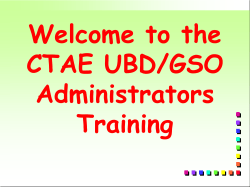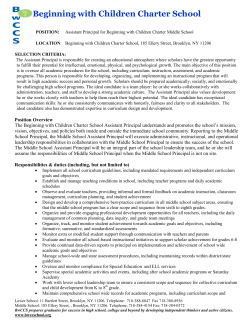
ACS WASC School Report Sample Chapter IV Responses
ACS WASC School Report Sample Chapter IV Responses A4: Measurable Effect of Professional Development There are effective operating processes that determine the measurable effect of professional development, coaching, and mentoring on student performance. Indicator: Prompt: Comment on the effectiveness of the processes in determining the measurable effect of professional development, coaching, and mentoring on student performance. Provide evidence about whether the professional development/learning has had a positive impact on student learning. Findings Our two-pronged professional development program (described in Chapter I) has had the greatest impact through the school-based portion. Our focus on strengthening writing for all students has not only improved students’ actual writing measurably but strengthened our internal school culture of personal reflection and growth on the part of all instructional staff members largely due to coaching and mentoring within academic departments and across our career path structure. However, we do not have an agreed upon common writing rubric for our school. Almost all staff report that the personal coaching and mentoring by our English/Language Arts specialist has been key followed by deep discussion in personal interviews has deepened all discussions giving a clearer focus on our schoolwide efforts to improve student performance. This initial leadership has been greatly broadened as teachers at all grade levels have joined the leadership of our professional development cadre. This side benefit, the comradery of staff has increased with greater understanding and respect for all members. At some level, this has been the greatest benefit as it makes all our work is stronger! This local, in-house model has been so successful, we plan to begin the same type of focused, long-term professional development as we work to improve students’ problem solving skills. District guided professional development has focused primarily on the effective use of technology in the classroom. We’re likely about 40% of the way in basic knowledge, however, only five of our teachers identify themselves as “experts” in this area. Two teachers still consider themselves “novices;” the bulk of the teachers consider themselves “emerging users.” Supporting Evidence Meeting records Student work Teachers’ selfreflective evaluations Student scores on inhouse writing assignments Student and teacher interviews (10% stratified random sample) State & local data in Chapter I Classroom observations B2. Instruction Criterion The professional staff a) uses research-based knowledge about teaching and learning; and b) designs and implements a variety of learning experiences that actively engage students at a high level of learning consistent with the school’s purpose and schoolwide learner outcomes. Challenging and Varied Instructional Strategies The teacher strengthen student understanding and achievement of the learning outcomes through the use of a variety of instructional strategies that are selected on the basis of the learning purpose(s) and effectively engage students in a high level of learning the academic standards and the schoolwide learner outcomes. This includes the integration of multimedia and technology as appropriate. Indicator: Provide a range of examples from examining students working and their work that give insight to the degree to which all students are actively engaged in learning to achieve the academic standards and the schoolwide learner outcomes. This includes students demonstrating critical thinking, problem solving, knowledge and application, and the development of a wide range of technological skills. Prompt: Findings Supporting Evidence Using classroom observations over the past two years conducted by district and site administrators and teachers, staff found that a majority (well over 70%) of instructional staff members differentiate instruction based on process at least some (approximately 20%) during each class period. The types of differentiation identified were all around the process of learning: independent and group/pair work, the use of technology, and different levels of support. However, differentiation was almost always by whole class not by individual or clusters of students. Classroom observations To further refine the data, instructional staff members tallied changes in strategies (process and product based only) in each classroom over a period of one month. These findings essentially matched those of the external evaluators – Some differentiation, but, perhaps not enough, and still class-based. The least used of the strategies were technology and differentiated products. A part of this is related to the general lack of technology equipment schoolwide and the fact that a majority of our teachers are still not comfortable with much of the technology. Classroom observations Teacher and student surveys (Results in VC workroom) Teacher and student interviews Student work samples Not unexpectedly, some instructional staff members (primarily instructional assistants) seemed always to be responding to the varying needs of students. In addition, none of the findings supported attention to the critical learner need of vocabulary development. Thus, some differentiation is occurring, it’s very often unrelated to identified overall student needs and there is no evidence that any of this – particularly technology – has affected student learning. Consider adding grade-level responses which might show additional differentiation. Classroom Observations Focus Group followed by full faculty discussions B3. How Assessment is Used Criterion Teacher and student uses of assessment are frequent and integrated into the teaching/learning process. The assessment results are the basis for (a) measurement of each student’s progress toward the schoolwide learner outcomes and academic standards, (b) regular evaluation, modification, and improvement of curriculum and instructional approaches, and (c) allocation of resources. Modifications/Decisions based on Assessment Data Assessment data is collected and analyzed and used to make changes and decisions about curriculum, instruction, professional development activities and resource allocation. Teachers modify and revise the curriculum and instruction as a result of student assessment, both collectively and individually. Indicator: Evaluate the effectiveness of how assessment data is collected, analyzed, and used to make changes and decisions about curriculum, instruction, professional development activities, and resource allocation. Prompt: Our work during the self-study has not identified any instances where assessment data (formative or summative) has been collected, analyzed, and used as a basis to make decisions and changes in the curricular design implemented or instructional practices employed. The curriculum has been unchanged for past 5 years. Professional development has been largely directed at implementing the Common Core State Standards. Discussions about data have mainly been on how to raise scores on high-stakes tests. We have a deepened understanding of the need to reflect on the implications of assessment results both to guide curricular implementation and drive instructional practices. The view of student performance evaluation must be analyzed over a larger scale than just a test or a grade. Our only sense of “preparation for success in college, career, and life” is based on grades and an informal follow-up process where we collect interview data from graduates. Those graduates who return generally report they were prepared for high school. The discussion which occurred around this Prompt was both short and difficult as we struggled to understand our ongoing use of data and its basic non-impact on our processes. Consider adding grade-level responses to further differentiate. Evidence: Faculty/Grade-level meeting discussion notes; data presented in Chapter I; interviews with graduates; the school plan; and three grant applications for technology funds Conclusions Prompt: Comment on the degree to which this criterion is being addressed. While staff have participated in a great deal of diverse professional development during the past three years, no measure of its true effectiveness in improving student learning have been implemented. In addition, no substantial improvement has occurred in overall student learning over that time frame as we examine students’ grades and performance on nationally normed standardized tests.. Comment on the degree to which this criterion impacts the school’s ability to address one or more of the identified critical learner needs. Prompt: However, the perceived benefit of in-house, colleague lead/driven professional development has been so well received we will continue the practice as we move forward in improving students’ writing and problem solving skills.
© Copyright 2025





















